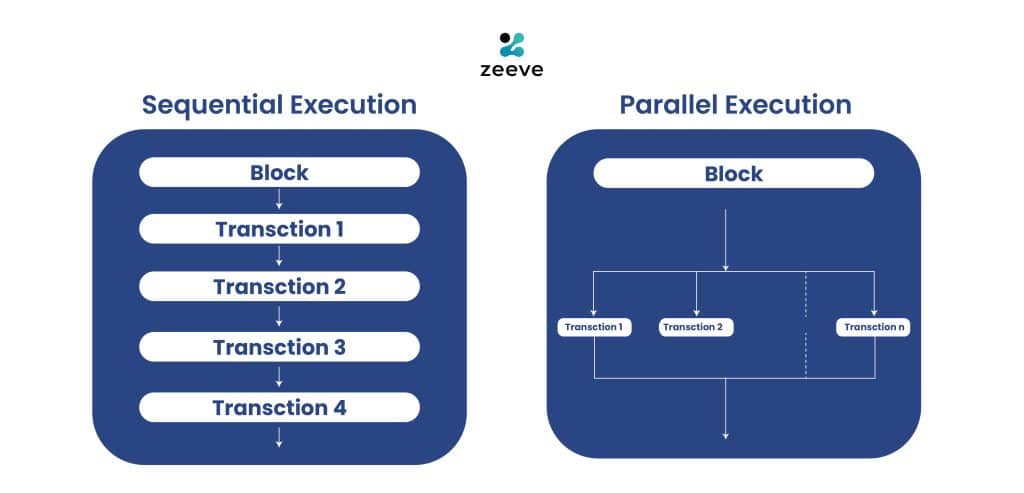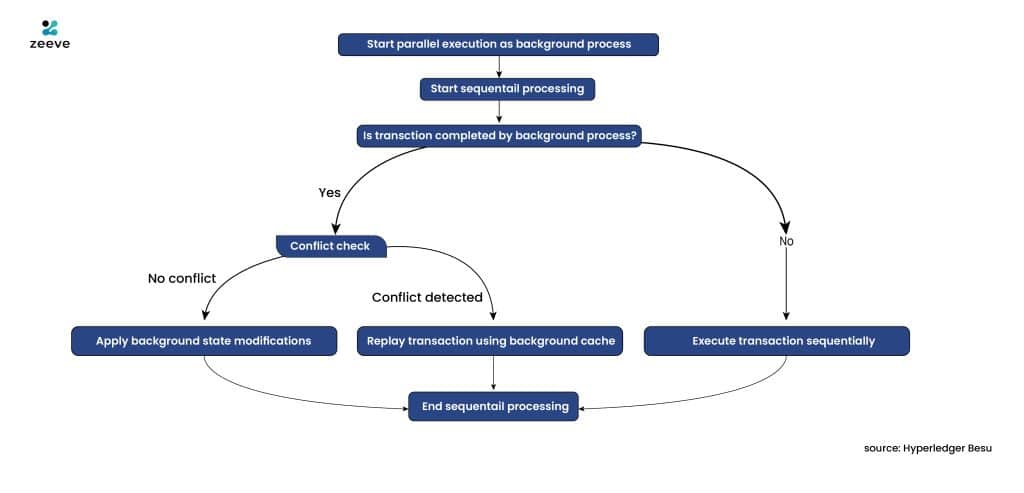- Zeeve
- Posts
- Parallel Transaction Execution: A Sneaky Update in Hyperledger Besu v24.7.1
Parallel Transaction Execution: A Sneaky Update in Hyperledger Besu v24.7.1

Hyperledger Besu continues to launch updates and next-gen features to maintain its performance as a promising Ethereum execution client. As a huge update in v24.7.1, Besu has now introduced ‘Parallel Transaction Execution’. Permissioned and permissionless chain building with Hyperledger Besu can leverage this feature to achieve unparalleled scalability, higher throughput, and better performance.
The Besu team claims that their idea of parallel transaction execution is influenced by the statistics coming from Reth’s research. Their research revealed that around 80% of storage slots on Ethereum are independently accessed. Which means that parallelism can be easily done on an EVM-compatible network like Hyperledger Besu, and it could offer 5x better improvement in overall speed and performance.
Let’s explore ‘Parallel Transaction Execution’ in Hyperledger Besu to understand its features, underlying mechanisms, applications, and the key benefits it brings to the existing Besu network.

Parallel execution and the challenge with sequential processing
Parallel transaction execution or parallelization refers to the method of structuring a blockchain network to process various transactions at the same time. This mechanism allows for better use of resources like blocks, slot storage, and memory, thereby unlocking enhanced scaling, lower gas cost, and extremely higher throughput. Solana and Aptos are the early implementers of parallel execution. Whereas, in sequential transaction processing, transactions are executed in order– one after the other. Chains like Bitcoin, Litecoin, Ethereum and Layer1/Layer2 EVM chains utilize this sequential transaction execution.

Parallel transaction execution in Hyperledger Besu
Hyperledger Besu adopts an optimistic approach to parallel transaction execution. This allows Besu to work with an optimistic assumption that all the transactions can be executed simultaneously without any conflict. To avoid further interruptions, Hyperledger Besu runs parallel execution in the background, allowing the sequential execution to complete seamlessly.
To achieve parallelism, Besu leverages a Bonsai design to efficiently manage all the slot storage, account, and memory’s code changes. Bonsai is a novel storage structure that is designed to enable various enhancements into Besu architecture. This Bonsai feature is known as ‘Accumulator’ in the Hyperledger Besu network, which keeps track of addresses and slots to determine if any slot is modified during the transaction’s execution or regarding any information change. Therefore, Besu does not need to do much heavy lifting; it only requires collecting essential data from the accumulator, matching it with the modified slots, and then examining conflicts. Transactions that have interacted with any conflict or modified accounts will be excluded from the parallel execution process. Now, Let’s move on to understand the working mechanism.
The working mechanism
Below is a brief and simple explanation of how parallel transaction execution works in Hyperledger Besu:
Checking for transaction execution completion: Besu Network, coupled with the Bonsai database layer, will first confirm if a transaction is successfully completed through the background thread or if it’s still ‘finalized’.
Importing transactions into the Block: Even when a transaction is completed, Hyperledger Besu re-examines it to see if any modification-related conflicts occur due to the transactions previously executed. Here’s a snapshot of the process:
No Conflict: If there’s no conflict, Hyperledger Besu goes on to apply state modifications (which are already generated in the background) to the blocks.
Conflict Detected: If a conflict is detected, Besu replays the transaction. For this, the network utilizes a background cache that improves the existing efficiency.
Check out the graphical explanation of the whole parallel transaction execution system in Hyperledger Besu:

Main benefits of Hyperledger Besu’s Parallel Transaction Execution
As discussed, parallel transaction processing in Hyperledger Besu mainly focuses on improving performance for all the projects built with this. Below are some of the metrics that show improvement in overall capabilities of Besu upon implementation of the parallel execution system:
Faster block processing: Block processing on Besu has seen a notable improvement of around 25% to 45%, reducing the processing time from 282 ms to 207 ms. Besu achieves this with almost zero usage overhead in the resource.
Increased execution throughput: Parallel processing allows Hyperledger Besu to better utilize the network’s resources, thereby increasing the throughput to offer an average of 96 Mgas/s and 250 Mgas/s at peak.
Low sync time: Node synchronization time on Besu is spotted at 27 hours and 5 minutes while the time to import block was approx 6ms on average.
Payload call time: With parallel execution, Besu experiences significant improvement in SLOAD operation time, which results in reducing the payload call time from approximately 251.68ms to 172.04ms on average.
Note: The metrics are based on nodes running with Azure VMS with a configuration of Standard D8as v5.
Applications of Hyperledger Besu’s Parallel Transaction Execution
Parallel transaction execution optimizes Hyperledger Besu for substantial performance improvements, making it an absolute solution for a range of use cases, including the below main applications:
High-volume DeFi applications: Hyperledger Besu’s parallel execution makes it an ideal Ethereum client for building high-volume applications for the DeFi sector. Applications like cross-chain exchanges, flash loan platforms, asset management protocols, and banking solutions are now possible to build on Besu. Its upgraded ecosystem will allow all these applications to scale endlessly while increasing throughput to accommodate the next millions of users. A real-world example is Public Mint, which is developing a blockchain network to make decentralization-backed financial benefits easily accessible to everyone.
Web3 gaming: Evidently, parallel execution in Besu enables low latency and very high throughput, which makes it a preferred choice for next-gen gaming applications both in AAA titles and indie categories. The architecture is designed to allow for massive transaction processing, fast confirmation, and efficient management of in-game assets. Palm Studio, a creator-focused NFT platform has created Palm Network with Hyperledger Besu that can interoperate directly with the Ethereum ecosystem.
Enterprise solutions: With a focus on speed and performance, Hyperledger Besu is also a feasible option for cutting-edge enterprise solutions for supply-chain management, decentralized identity (DID) solutions, real-world asset tokenization, energy sector applications, public sector operations, and more. Top-grade enterprises building on Besu are LACChain network, Asian Development bank, The BIS Innovation Hub & the Hong Kong Monetary Authority (HKMA), and more.
As required, these applications can build their private consortium chains or a permissionless network. Hyperledger Besu will ensure high performance and faster consensus for both of these choices.
Wrap up!
Parallel transaction execution definitely brings a next-level advancement in Hyperledger Besu, but it’s quite a new feature at the moment. Considering this, Hyperledger is encouraging more projects to experiment with it. This feature of parallel execution is especially aligned for enterprises looking to deploy high-performance blockchain networks to support their applications. All these together make Hyperledger Besu an even more competitive choice for enterprises and businesses in the web3 space.
If you’re planning to build a permissionless or permissioned chain with Hyperledger Besu’s parallel transaction execution, connect with our team. Zeeve accelerates your Hyperledger Besu network launch with easy-to-use development tools and a highly efficient infrastructure platform. For more information about our blockchain-related services or appchain and rollups offerings, send us your queries via mail or schedule a one-to-one call for an upfront discussion.